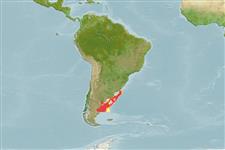Actinopterígios (peces con aletas radiadas) >
Pleuronectiformes (Flatfishes) >
Paralichthyidae (Large-tooth flounders)
Etymology: Paralichthys: Greek, para = the side of + Greek, ichthys = fish + Greek, suffix, oides = similar to (Ref. 45335). More on author: Jordan.
Medioambiente / Clima / Gama
Ecología
; marino demersal; rango de profundidad 50 - 190 m (Ref. 36453), usually 70 - 100 m (Ref. 43588). Subtropical, preferred ?; 34°S - 47°S
Southwest Atlantic: Brazil to Argentina.
Tamaño / Peso / Age
Maturity: Lm ? range ? - ? cm
Max length : 32.0 cm TL macho / no sexado; (Ref. 43588); 38.0 cm TL (female)
Short description
Morfología | Morfometría
Espinas dorsales (total): 0; Radios blandos dorsales (total): 79-92; Espinas anales 0; Radios blandos anales: 65 - 72; Vértebra: 38 - 39. Caudal fin double truncate (Ref. 27363). Almost wholly ambicolorate, the blind side is darkly pigmented except for the anterior portion of the body which has dark pigments only on the opercle, subopercle, a small region adjacent and dorsal to the head, and the distal half of the pectoral fin; two lighter pigmented areas were present on the unpigmented dorsal region of the head. The blind side had one of the 3 typical ocelli (upper one) in the same position with that of the ocular side (Ref. 34245).
Prefers hard or sandy substrates, rarely on mud (Ref. 43588). Feeds on fishes and cephalopods (Ref. 36453).
Life cycle and mating behavior
Madurez | Reproducción | Puesta | Huevos | Fecundidad | Larva
Distinct pairing (Ref. 205).
Nakamura, I., T. Inada, M. Takeda and H. Hatanaka, 1986. Important fishes trawled off Patagonia. Japan Marine Fishery Resource Research Center, Tokyo. 369 p. (Ref. 27363)
IUCN Red List Status (Ref. 115185)
CITES (Ref. 94142)
Not Evaluated
Threat to humans
Harmless
Human uses
Más información
ReferenciasAcuiculturaPerfil de acuiculturaRazasGenéticaFrecuencias de alelosheritabilidadEnfermedadesProcesamientoMass conversion
ColaboradoresImágenesStamps, CoinsSonidosCiguateraVelocidadTipo de nataciónSuperficie branquialOtolitosCerebrosVisión
Herramientas
Special reports
Download XML
Fuentes de Internet
